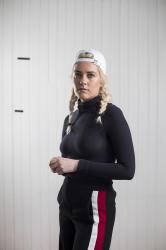“There’s a lot of creative thinking in math. It’s playful and exploratory,” visual artist Jóhanna Ásgeirsdóttir explains, sitting in front of a chalkboard covered with geometric shapes and equations. “Math doesn’t need to be visual to have a connection with how art works or how artists think. They are the same thing—both are having an interest in the world, looking at them closely, and trying to understand them.”
Jóhanna is joined by fellow artist Daníel Magnússon, who, along with artist Anna Hrund Másdóttir, just opened up a workshop at Ásmundarsalur entitled ‘Slembilukka.’
Math is art
“We’re calling it a lab or workshop, but we will be here thinking about math. We’re all visual artists so we will be thinking about math as an art or philosophy,” she continues. “But it’s open—we don’t know where it’s going to go.”
The trio will eventually move their lab to the main exhibition hall in Ásmundarsalur, presenting an exhibit entitled ‘Fullkomið Firðrúm’. But for now, they spend their days diving into all facets of mathematics—from probability to higher dimensions to discrete structures—looking at them from the perspective of fine artists.
Lessons from Euler
The group recently tackled mathematician Leonhard Euler and the Seven Bridges of Königsberg, a problem that laid the foundations for graph theory.
The gist of the experiment is whether it was possible for one to cross all seven bridges in the Prussian city of Königsberg in one walk without double crossing one bridge. This deceptively simple problem had baffled many, until Euler changed the game. Instead of focusing on the location of each bridge, he zeroed in on the number, creating a diagram of the city that put a “point” on each area of the town and “lines” connecting them. Of course, you might know these symbols as other things: vertices and edges. Yes, Euler had made what we now call a graph, putting into motion future studies on how spaces interact with each other.

Photo by Art Bicnick
“It seems like a simple puzzle that would have no consequences with anything else, but it describes how systems with multiple points and connections work, which is now used in transmitting information on the internet or putting pipes in a house,” Jóhanna explains.
The group also explored Euler’s polyhedron formula, which describes how, if you are in three dimensions, you can take the vertices of a polyhedron, subtract the edges and add the faces, and you will always get two.
“I thought these were disconnected ideas—the polyhedrons and the bridges—but you can transform a polyhedron into a two-dimensional network and the rules apply, so they are intimately connected. This is simple math, addition and subtraction, but they have large systematic consequences,” she continues. “I’ve been thinking about the geometry of that while Daníel was thinking about the systems. But it’s the same thing.”
It’s the basis of shapes—the basis of art.
A place for experiments
The workshop aims to reach a much broader audience than just the three of them and their own discoveries. The lab is for everyone, so ‘Slembilukka’ is opened up to the masses on Thursdays. Students can bring their math homework if they need help, or just come sit and discuss any special mathematical interests they have.
“It’s a place for experiments,” Jóhanna says. “People can come in and talk about these connections between art and math.” She’s also quick to note that while the official office hours are on Thursday, the group are there nearly all the time, so feel free to stop in any day, if your Thursdays are already booked.
“We are all interested in changing the idea that math is only for scholars and educated people,” Daníel concludes. “Math is for everybody and everybody can learn math.”
Note: Due to the effect the Coronavirus is having on tourism in Iceland, it’s become increasingly difficult for the Grapevine to survive. If you enjoy our content and want to help the Grapevine’s journalists do things like eat and pay rent, please consider joining our High Five Club.
You can also check out our shop, loaded with books, apparel and other cool merch, that you can buy and have delivered right to your door.
Also you can get regular news from Iceland—including the latest notifications on eruptions, as soon as they happen—by signing up to our newsletter.
Buy subscriptions, t-shirts and more from our shop right here!
















